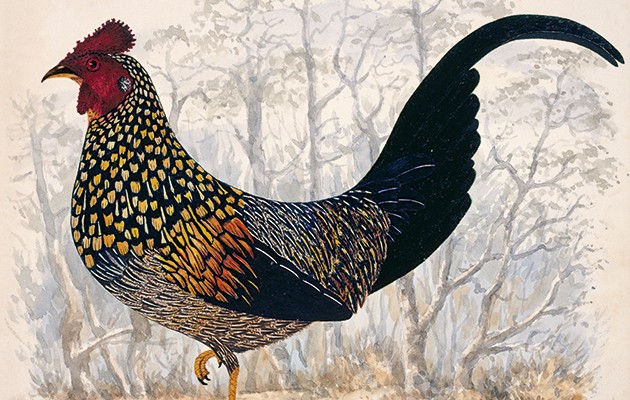Mostly found on the Indian peninsula and with relatively high numbers, the Grey junglefowl is listed as "Least Concern" in the IUCN Red List of threatened species
The Grey junglefowl is very distinctive, with neck hackles dotted with pale yellow spots, and its feathers have been in such high demand a ban was put in place in 1968 on exporting the birds from India.
For a pheasant closer to home, read Caucasian pheasant: the Old English Blackneck.
GREY JUNGLEFOWL
The Grey junglefowl is one of the wild ancestors of the bird we know and love deep fried in a secret mix of herbs and spices. It is found mostly in the Indian peninsula, where it lives on the forest floor and in open scrubland.
It has a wide range and numbers are relatively high, so it is listed as “Least Concern” in the IUCN Red List of threatened species.
In the Sixties however, hunting was having a worrying impact on the bird, for the pot and also for its feathers, sought after for fly-tying. The Grey junglefowl has distinctive neck hackles dotted with pale yellow spots with a waxy appearance and feel. These have been used in salmon and trout flies since the 19th century. The “nail” or cape feather is the most valuable; the spots mimic the fly’s eyes. The lower nape grey and transition feathers can also be used for streamers, steelhead and salmon patterns. Demand for Grey junglefowl capes and feathers led to a ban on exporting the birds from India in 1968. Fly-tyers now rely on captive-bred birds. Prices depend on the size and quality of the feathers, but a good Grade A cape will cost upwards of £50.
The Grey junglefowl is missing a gene that makes domestic chickens susceptible to leucosis. Crossbreeding with the Grey junglefowl can eliminate this gene after three generations. It is also resistant to avian leukaemia and research into this species has resulted in one form of human leukaemia being limited.
This is an example of the importance of conserving species in the wild, not just preserving biodiversity for its own sake but as insurance against emerging diseases. The time may come when we need to go back to our livestock’s wild ancestors for a solution to a new threat.





